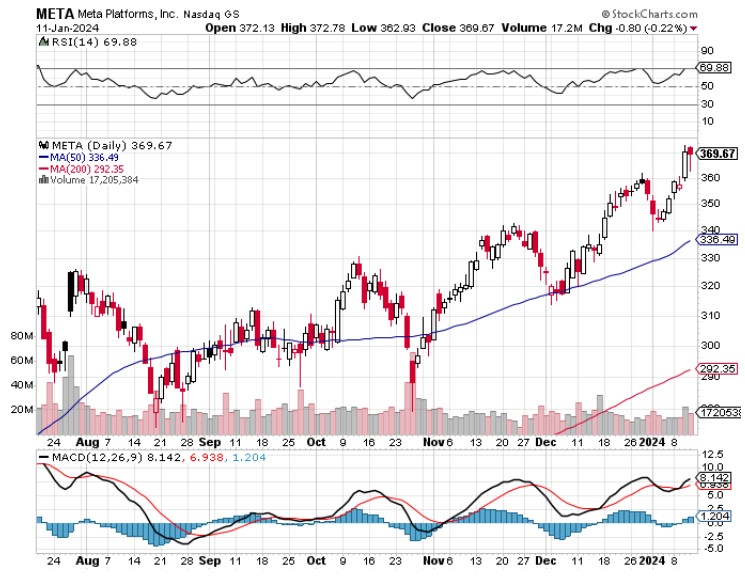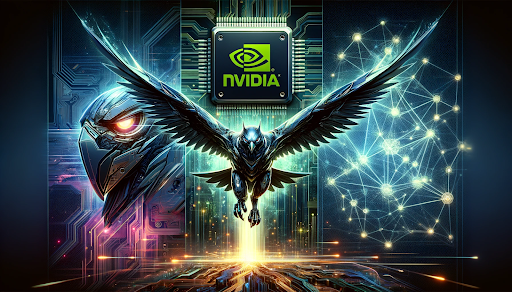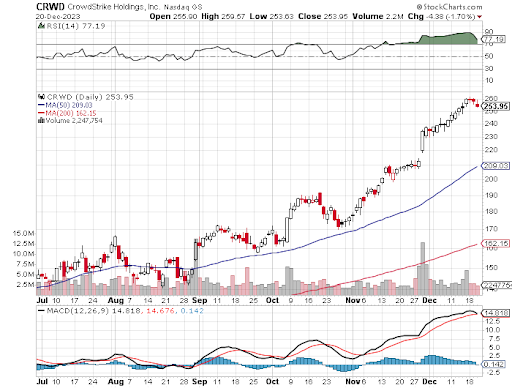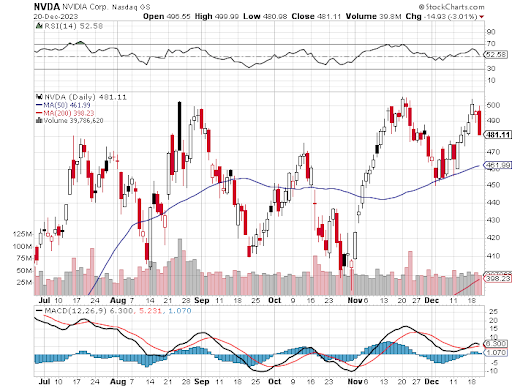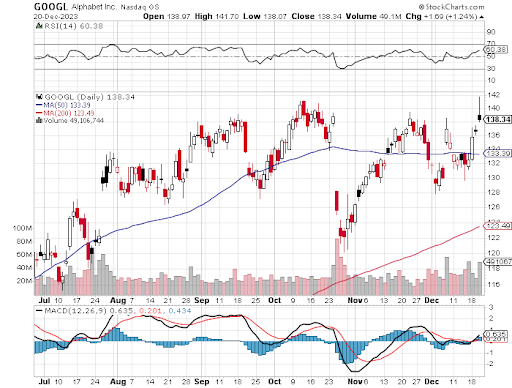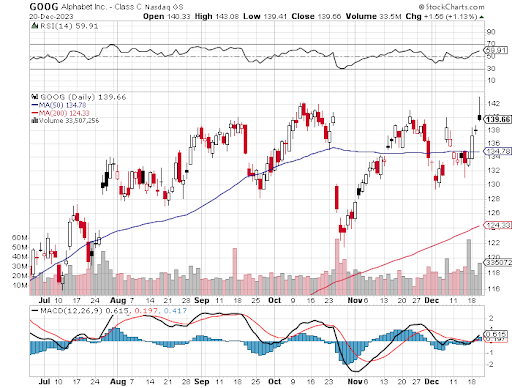When John identifies a strategic exit point, he will send you an alert with specific trade information as to what security to sell, when to sell it, and at what price. Most often, it will be to TAKE PROFITS, but, on rare occasions, it will be to exercise a STOP LOSS at a predetermined price to adhere to strict risk management discipline. Read more
(META), (NVDA)
All aboard the Meta Express! Next stop: a staggering trillion-dollar valuation.
Remember 2023? The year AI took off like a rocket, not seen since those wild early days of the internet. At the time, Nvidia (NVDA), bless their silicon hearts, soared a stratospheric 240% and breezed into the trillion-dollar club - a place so exclusive, you'd think they'd have a secret handshake.
Now, it looks like it might be Meta Platforms’ (META) turn. After a staggering 200% rally in the past year, some might think this tech stock is just catching its breath. But here’s the kicker: Meta, valued at just over $900 billion, is knocking on the trillion-dollar club's door, and I'm betting they're about to burst it wide open in 2024.
So let's rewind a bit to the days when Meta was about as popular as a payphone.
Back in 2022, their stock was down in the dumps at $89. Wall Street was turning up their noses at Meta's big spending with little to show for it. But CEO Mark Zuckerberg, a man not known for taking things lying down, got Meta's house in order. Layoffs, cost-cutting, you name it - he did it.
And what do you know? Cash flow and revenue started climbing faster than a squirrel on an espresso buzz.
What we've seen with Meta's cash flow and stock price is nothing short of a full 360. But this isn't just a comeback story; it's about a tech titan reinventing itself with the secret sauce – AI.
Despite the 200% leap, some folks on Wall Street are still snoozing on Meta. Why? Because they're missing the AI big picture.
Meta is throwing billions into AI like it's going out of style. They're weaving AI into the very fabric of their business. Think Facebook and Instagram ads turbocharged by AI for precision targeting.
And it's not just ads. Meta's got an AI division cooking up some sci-fi stuff, like real-time cross-language chit-chat (hello, Llama 2) and funky augmented reality gadgets for their Quest brand.
Now, let's get to the nitty gritty. Meta's financials and AI mojo are getting the analysts all hot and bothered. The word on the street is a cool 20% annual earnings growth. And despite being the belle of the ball with a 200% gain, Meta's trading at a forward P/E ratio of 25 based on 2023 earnings.
For a tech heavyweight growing at 20%, that's not just reasonable; it's like finding a designer suit at a thrift store price.
On top of that, Meta’s story is only getting juicier. The user base is growing, AI's about to hit warp speed, and the top brass at Meta has shown they can dodge a curveball and hit it out of the park. There’s more sizzle here than what's baked into the stock price.
The narrative that’s emerging is one of a tech giant not just recovering, but aggressively pivoting into new, uncharted territories. This AI infusion surpasses any tech upgrade. It's a paradigm shift, blending cutting-edge technology with Meta's already massive social media empire.
So, what’s the bottom line? Meta is not just knocking on the door of the trillion-dollar club; they're about to throw it off its hinges.
Looking at their recent moves, it’s clear that Meta's foray into AI isn't just about keeping up with the Joneses. It’s a bold statement of intent, a signal that they’re not content with playing second fiddle in the tech symphony.
With AI as their new best friend, don’t be shocked if Meta struts past that trillion-dollar mark like it’s the red carpet. For the eagle-eyed investors, this is your front-row ticket to the show. Meta in 2024? That's not just an investment story; it's a Hollywood blockbuster in the making. And I, for one, can’t wait to see how this film ends.
Materials are the building blocks of our world, from the sleek screens we swipe to the life-saving implants in our bodies. But this foundation of technology and medicine is undergoing a revolution, driven by the relentless innovation of artificial intelligence (AI). No longer mere passive elements, materials are becoming programmable and purpose-built, tailored for specific needs with an unimaginable degree of precision. This article delves into the fascinating world of AI-powered materials development, showcasing real-world companies spearheading this transformative journey.
Unveiling the Secrets: AI as a Chemist
Traditionally, discovering new materials has been a slow and laborious process, often relying on serendipity and trial and error. But AI is changing the game by acting as a virtual chemist, sifting through massive databases of existing materials and their properties. Armed with algorithms trained on quantum mechanics and other physics simulations, AI can predict how atoms and molecules interact, revealing the hidden potential within uncharted territory.
For example, the company Intellegens uses AI to analyze millions of potential molecules, filtering them based on desired characteristics like conductivity, flexibility, or thermal stability. This rapid virtual prototyping allows them to identify promising candidates for applications like organic photovoltaics or flexible electronics, significantly accelerating the discovery process.
Building the Dream: Engineering Atoms from Scratch
Once a promising material is identified, the next challenge is designing its structure at the atomic level. This is where AI truly shines, acting as a master architect, manipulating the arrangement of atoms to achieve specific performance goals. Companies like NVIDIA are developing powerful AI tools that can optimize material structures for desired properties, such as maximizing strength-to-weight ratios or tailoring electrical conductivity.
Imagine lightweight aircraft wings forged from AI-designed composites, or batteries with ten times the current capacity, all thanks to the meticulous craftsmanship of virtual atom-smiths. These are no longer futuristic fantasies; they are the tangible possibilities unlocked by AI-powered materials engineering.
Beyond the Lab: AI Takes Materials to the Factory Floor
The magic doesn't stop in the virtual world. AI is also transforming the physical process of materials synthesis and manufacturing. Companies like Samsara are developing AI-powered platforms that optimize production processes in real-time, automatically adjusting factors like temperature, pressure, and chemical inputs to ensure consistent, high-quality materials.
Think of it as a self-driving factory floor, where AI acts as a watchful guardian, constantly monitoring and fine-tuning the production process to minimize waste and maximize yield. This not only translates to cost savings but also opens the door to the creation of previously impossible materials with complex, multi-layered structures.
Medical Marvels: AI tailors materials for the body
The impact of AI-powered materials extends far beyond the realm of gadgets and gizmos. In the field of medicine, AI is helping to create biocompatible materials that seamlessly integrate with the human body. Companies like Stryker are utilizing AI to design personalized implants for joint replacements, ensuring a perfect fit and reducing the risk of rejection.
Imagine AI-designed artificial limbs that mimic the flexibility and strength of natural bone, or wound dressings that accelerate healing by actively interacting with the body's tissues. These are the life-changing possibilities that AI-powered materials hold for the future of healthcare.
Challenges and Promises: The Road Ahead
While the potential of AI in materials development is immense, there are still hurdles to overcome. The complex interplay of material properties and real-world conditions requires continual refinement of AI algorithms and simulation models. Additionally, ethical considerations regarding the environmental impact and unintended consequences of novel materials must be carefully addressed.
Despite these challenges, the future of materials is undoubtedly interwoven with the threads of AI. As research progresses and collaboration between scientists, engineers, and technology developers strengthens, the materials of tomorrow will not be mere passive substances, but active participants in shaping a brighter, more sustainable, and healthier world.
Links to Companies Using AI for Materials Development:
- Intellegens: https://intellegens.com/
- NVIDIA: https://www.nvidia.com/en-us/design-visualization/technologies/vmaterials/
- Samsara: https://www.samsaraeco.com/
- Stryker: https://www.stryker.com/
This is just a glimpse into the transformative power of AI in materials development. It is a journey fueled by scientific curiosity, relentless innovation, and a shared vision for a future where materials, like AI itself, are tools for building a better tomorrow.
Options trading, once a domain reserved for sophisticated investors and Wall Street veterans, is undergoing a metamorphosis. At the helm of this transformation stands a powerful force: artificial intelligence (AI). As algorithms evolve beyond mere number-crunching, they're poised to reshape the landscape of options trading, ushering in an era of unparalleled efficiency, precision, and perhaps even democratization. Let's delve into the crystal ball of finance and predict what the future holds for AI in options trading, exploring both its opportunities and the challenges it presents.
Beyond Predictability: The Rise of Autonomous Options Strategy Generation
Current AI applications in options trading primarily focus on order execution and risk management, optimizing trade timing and minimizing losses. While valuable, these functionalities merely scratch the surface of AI's potential. The game-changer lies in autonomous strategy generation. Imagine AI analyzing vast datasets of market data, historical trends, and real-time news, then weaving these threads into bespoke options strategies tailored to individual investor goals and risk profiles. This isn't a distant dream; projects like Akuna Capital's AI-powered platform, VIKING, are already demonstrating the capability of algorithms to generate and execute complex options strategies within milliseconds.
Personalized Portfolios: From DIY to Auto-Pilot
For novice and seasoned investors alike, navigating the intricate web of options contracts can be daunting. AI will act as a digital sherpa, crafting customized portfolio allocations based on individual risk tolerance, investment horizons, and desired returns. Forget cookie-cutter strategies; AI will consider your unique financial situation and goals, dynamically adjusting your portfolio as market conditions shift. This democratizes options trading, making sophisticated strategies accessible to a wider investor pool.
The Market Whisperer: Unlocking the Power of Predictive Analytics
Market movements are notoriously fickle, often defying even the most astute predictions. But AI, trained on mountains of data, may hold the key to unlocking predictive power. Algorithms can analyze not just traditional quantitative data but also qualitative factors like social media sentiment and newsfeeds, gleaning insights invisible to the human eye. These insights can then be translated into predictive models, enabling traders to anticipate market shifts and capitalize on emerging trends before they unfold.
The Human Factor: Collaboration, Not Replacement
The rise of AI doesn't herald the demise of human traders. Instead, it promises a future of augmented expertise, where AI acts as a powerful tool to amplify and refine human decision-making. Traders can leverage AI's analytical prowess to identify promising opportunities, validate their own intuitions, and back-test potential strategies with unparalleled speed and accuracy. This collaborative approach, far from diminishing the human element, elevates it, allowing traders to focus on higher-order tasks like strategic planning and risk assessment.
Beyond the Horizon: Challenges and Ethical Considerations
While the future of AI in options trading is brimming with promise, it's not without its challenges. Issues of algorithm transparency, data privacy, and potential market manipulation must be addressed to ensure a fair and ethical trading environment. Furthermore, the reliance on AI could exacerbate existing systemic risks, leading to herd behavior and market meltdowns if algorithms follow the same flawed models. Addressing these challenges through regulatory frameworks and responsible development practices is crucial to harnessing the potential of AI for good.
A Brave New Market: Democratization and the Rise of the Supermind
In conclusion, the future of AI in options trading paints a picture of a radically transformed market. On the one hand, this future promises democratization, making sophisticated strategies accessible to a wider audience and potentially leveling the playing field. On the other hand, it raises concerns about ethics, transparency, and systemic risk. Ultimately, navigating this brave new world requires a balanced approach, one that embraces the power of AI while carefully mitigating its potential pitfalls. As AI evolves into a collaborative partner, a "supermind" augmenting human expertise, the options market may one day resemble a chessboard, where humans and machines strategize together, locked in an intricate dance of intellect and foresight. It will be a fascinating journey, and one whose outcome will define the future of finance.
(IBM), (TRI), (PLTR), (VERI)
In a world where legal dramas often unfold with more twists than a Hollywood thriller, Chief Justice John Roberts Jr. has veered off the beaten path, turning the spotlight on a new protagonist in the courtroom drama: artificial intelligence (AI).
Cutting through Supreme Court melodramas and the 2024 presidential election buzz, Roberts' year-end report spotlights AI as a legal game-changer. It’s not just legalese; it's an investor's guide to the next tech boom.
Imagine AI and legal research going together like peanut butter and jelly, offering everyone from hotshot lawyers to the average Joe unprecedented access to the world of legal mambo jumbo.
But Roberts isn’t just selling a tech utopiaIn fact; he’s quick to flag up the potential issus - think privacy nightmares and a justice system that feels about as personal as a robocall.
Yet, for all the potential AI missteps, like leading lawyers on a wild goose chase with phantom legal cases, Roberts still bets big on the human factor. He’s convinced that when it comes to the really tricky, gray-area stuff, it's going to take more than a machine's cold logic to cut the mustard.
Now, let’s delve into how this technology could revolutionize the legal industry from an investor's perspective. After all, it feels like Roberts’ musings are like a treasure map to a gold mine in the burgeoning legal AI market.
With the global legal services market valued at $950 billion, largely dependent on manual analysis of communications, the potential for AI-driven transformation is massive.
Take a look at IBM (IBM) and Thomson Reuters (TRI), strutting their stuff with AI platforms like IBM’s Watson. These behemoths are not just tweaking the game; they’re the MVPs turning legal research into child's play for the masses.
IBM’s Watson, since 2011, harnesses AI and natural language processing, slashing the time for legal research, sharpening contract analysis, and even predicting case outcomes with a staggering 80% accuracy.
Embedded in law firms and legal departments, Watson has turned the tide in tasks like document review, morphing the once herculean effort into a streamlined process.
This shift in legal services doesn't only save time, but democratizes legal prowess, opening the gates for a wider pool of legal eagles. It's a disruptive force in a traditionally conservative industry, presenting a unique opportunity for forward-thinking investors.
Meanwhile, Thomson Reuters also flexes its AI muscle.
A recent Thomson Reuters Institute survey spotlights a shift in legal minds: 82% of surveyed lawyers see generative AI like ChatGPT fitting snugly into legal work, with 51% championing its deployment.
Surprisingly, only a scant 3% of law firms have actually taken the plunge and started using this AI tech.
Given the growing interest in the technology, it feels like the legal profession’s standing on the edge of a diving board, ready to jump into the pool of an AI revolution.
This mixed bag of eagerness and hesitation, especially when it comes to the nitty-gritty of accuracy and client privacy, paints a picture of cautious optimism in the legal world.
And let me tell you, this is where the savvy investor should perk up their ears. It's a golden ticket of an opportunity in a market that's not just simmering – it's about to boil over.
On top of these, there are companies like Veritone Inc. (VERI) and Nuance Communications, taking the courtroom tech story to the next level with AI-powered transcription and speech recognition.
The legal transcription service sector, which converts recorded legal proceedings into text, represents 30% of all business transcription and is projected to be worth over $3 billion by 2029. This is not just a statistic; it’s a signal to investors about where the industry is heading.
And let’s not forget the dark horse, Palantir Technologies (PLTR). With its eye on the privacy ball, it’s addressing one of Roberts' big red flags head-on.
Putting your bets on Palantir is like backing the player who knows the value of a strong defense, especially when it comes to guarding personal data. This focus on privacy makes Palantir a compelling choice for investors who understand the critical importance of data security in today’s digital landscape.
But that’s not all. The legal AI scene is teeming with sprightly startups and smaller firms, cooking up everything from AI-driven legal crystal balls to high-tech contract analysis. Sure, they might be the wild cards of the investment world, but they’re also where you might find the next big jackpot.
With the global legal services market tipping the scales at $950 billion, largely dependent on manual analysis of communications, AI stands poised to revamp nearly half (44%) of legal tasks in the US and Europe.
This spells out a clear message to investors: the legal tech market is booming, with huge potential for AI integration.
So, there you have it. Roberts’ report is more than just legal eagle talk; it’s a clarion call to investors.
From the tech titans to the plucky upstarts, the legal AI landscape is a buffet of opportunities, each serving up a different flavor of AI’s role in the law. It’s an open invitation to join the fray, balancing the hunger for profits with a dash of ethics and a sprinkle of societal good.
Roberts, known for his “umpires call balls and strikes” analogy, throws us a curveball with a tennis reference this time. Just like tech replaced line judges in tennis, AI is set to revolutionize the legal game. But, he insists, when it comes to the nitty-gritty of legal judgment, nothing beats the good old-fashioned human touch.
For investors and legal buffs, Roberts’ insights are a ticket to understanding AI's role in law. It's a journey through a landscape where technology meets human judgment, a fertile ground for investment in a rapidly changing market.
(PLTR), (NUAN), (META), (TWTR), (GOOGL), (PANW), (CRWD), (ADBE), (CRM)
Shakespeare's "Uneasy lies the head that wears the crown" might as well have been penned for the ever-evolving world of artificial intelligence (AI), especially in its tryst with politics and democracy.
After all, this is a stage where technology and governance perform a delicate dance, often stepping on each other's toes.
So, let's peel back the layers of AI's potential threats to democracy. Moving beyond the typical concerns of fake images and misinformation campaigns, we look into a broader narrative where AI's profound and far-reaching impact on politics becomes evident.
Consider Mayor Eric Adams of New York City, who recently embraced AI to deliver multilingual robocalls to his constituents. A nifty tool for communication, no doubt, but it also blurs lines, creating an illusion of linguistic prowess that isn't actually there. This maneuver also raises questions about transparency and the ethical use of AI in political communication.
The brains behind these controversial AI calls? Voice Lab by Eleven Labs. This organization is the brainchild of former Google and Palantir (PLTR) employees. Voice cloning is their game, a technology that is as fascinating as it is controversial. We've seen it play out in various arenas, stirring up trouble in online forums and outsmarting voice authentication systems, thereby showcasing the inescapable duality of AI's capabilities.
To put this in a more comprehensive context, let's consider how this technology aligns with market trends and opportunities.
While Eleven Labs is not yet on the stock market, its presence draws attention to similar publicly traded entities such as Nuance Communications (NUAN), a heavyweight in conversational AI.
In the landscape of social media and content management, over at Meta (META) and Twitter (TWTR), AI has also become the new sheriff in town, policing a vast expanse of content. Needless to say, this is a herculean task akin to finding a digital needle in a haystack, with the added twist of the needle constantly shifting shape.
Similarly, Alphabet Inc. (GOOGL), the parent of Google, showcases a diverse application of AI. This is not confined to digital searches but across a spectrum of AI applications. From the self-driving ambitions of Waymo to DeepMind's forays into healthcare, Alphabet has been painting a broad stroke on the AI canvas.
Meanwhile, in response to incidents like the Voice Lab scenario, there is a heightened need for robust cybersecurity.
Companies like Palo Alto Networks (PANW) and CrowdStrike Holdings (CRWD) step into the limelight, offering advanced AI-driven cybersecurity solutions. Basically, they're the cyber equivalent of knights in digital armor.
When it comes to blending AI with creativity, Adobe Systems Incorporated (ADBE) and Salesforce.com Inc. (CRM) are leading the charge. Adobe is revolutionizing content creation with AI, while Salesforce is redefining customer engagement in political campaigning and fundraising.
Mayor Adams' advocacy for "ethical" AI usage mirrors a broader conversation about responsible AI governance. This dialogue plays a pivotal role in shaping the regulatory environment, thereby influencing AI's market potential — a narrative that reminds me of the tension between fear and fascination surrounding the internet in 1999, as famously expressed by David Bowie in an interview.
As we reflect on these developments, it becomes clear that AI's integration into various sectors presents both challenges and opportunities for astute investors.
Twenty-five years ago, the internet posed questions about its impact on the US Constitution. The digital world, once perceived as a fortress of freedom, now presents a complex terrain where truth and democracy often find themselves on shaky ground.
As we navigate the complex world of AI and politics, it becomes increasingly apparent that this symbiotic relationship will be a major source of intrigue — and perhaps even headaches — in 2024 and beyond.
(GOOGL), (NVDA), (MSFT), (IBM), (BIDU), (BABA), (TCEHY), (SFTBY), (SSNLF), (ASML), (SAP), (SIEGY)
The entire 2023 has emerged as the watershed year for artificial intelligence (AI), a field resonating everywhere from corporate boardrooms to pop culture. Amidst AI chatter, a saga unfolds at OpenAI – yes, the brainiacs leading the charge – reminding us of AI's unresolved complexities and staggering potential.
Generative AI is set to shake up a whopping 300 million jobs and could be churning out a jaw-dropping $4.4 trillion annually. That's trillion with a “T!”
But it's not just a corporate scramble; nations are also in a high-stakes race for AI supremacy, shaping a new geopolitical landscape.
However, this race isn’t focused on who can create the most advanced AI. It’s about who's calling the shots on AI applications, where the big bucks and brainpower are flowing, what the rulebook looks like, and how we’re keeping the tech titans in check.
Leading the pack in this global derby are none other than the U.S. and China, duking it out in their digital cold war.
Then, there’s the EU, which has been bossing AI regulation, with the U.S. trailing behind, and Canada – yes, the polite North – is the dark horse with its very own AI strategy.
In corners of the world like India, there's a race to hoard data, while Iran, sanctions and all, is elbowing its way to the top 10 in AI.
Truth be told, the U.S. and China sitting pretty at the top of the leaderboard isn't a shocker. The U.S. is hell-bent on keeping its lead in AI, while China is eyeing the crown of being the top AI innovation hub with a hefty RMB 10 trillion ($1.5 trillion) target by 2030.
Things got real when the White House threw a curveball, banning chip exports to China. Talk about upping the ante.
Now, here's where it gets even more interesting. In 2022, Uncle Sam saw 524 AI startups get funded. That's leagues ahead of everyone else.
Over the past decade, U.S. AI firms have been raking in the dough, outdoing Chinese firms by more than double.
The private sector is flexing its muscles, taking its share in AI from a measly 11% in 2010 to a whopping 96% in 2021. And get this – 70% of AI PhD hotshots in the States are working in the private sector.
Meanwhile, China's playing a different game. The government is the big player here, pushing AI in directions like drug development and gene research. They've got the world's biggest online crowd, so when they launch something like the Ernie Bot, it hits a million users in just 19 hours – ChatGPT took 5 days, just saying.
Now, let's dive into the movers and shakers in the AI world.
On the U.S. front, we've got giants like Alphabet Inc. (GOOGL), NVIDIA Corporation (NVDA), Microsoft Corporation (MSFT), and IBM Corporation (IBM) shaping the AI landscape. Alphabet's DeepMind is spearheading breakthroughs like protein structure prediction, while NVIDIA's GPUs are the muscle behind deep learning.
Microsoft's hefty investment in AI, including its partnership with OpenAI, is making waves, and IBM's Watson AI platform is a testament to their deep-rooted AI expertise.
Switching gears to China, Baidu, Inc. (BIDU), Alibaba Group Holding Limited (BABA), and Tencent Holdings Ltd. (TCEHY) are not just bystanders in the AI race.
Baidu is pushing the envelope with autonomous driving and AI chatbots, while Alibaba is using AI to revolutionize e-commerce and logistics.
Tencent, known for its investment in gaming and social media, is exploring various AI-driven technology solutions.
But it's not all about the U.S. and China. Look at Japan and South Korea. They’re pouring cash into AI to keep up with the times. Each has its own hurdles, though.
Japan’s staring down the barrel of a 789,000 software engineer shortage by 2030. That's going to sting their AI progress for sure.
And South Korea? They have tech chops but are sweating over a talent drought and less-than-stellar government backing. Their AI R&D budget got slashed by 43%, and their AI investment game lags behind the U.K.’s massive $18.2 billion.
Still, SoftBank Group Corp. (SFTBY) in Japan and Korea’s Samsung Electronics Co., Ltd. (SSNLF) have managed to remain major players, with SoftBank's Vision Fund making significant AI investments and Samsung advancing AI in electronics and smartphones.
Europe is not far behind, with the Netherlands’ ASML Holding NV (ASML) playing a pivotal role in the semiconductor industry, crucial for AI technologies.
In the UK, DeepMind Technologies, now a part of Alphabet's empire, is a critical part of AI innovation. And let's not overlook the EU's contributions, with Germany’s SAP SE (SAP) integrating AI into enterprise solutions, and Siemens AG (SIEGY) pioneering industrial AI applications.
In this global AI race, it's clear as day that whoever masters AI is going to be sitting pretty. Remember what Eric Schmidt, the former CEO of Google, said about tech shaping empires? He’s not wrong. Even Vladimir Putin’s thrown in his two cents, saying AI's the new crown jewel.
As the AI world order shapes up, it's going to decide a lot: which AI toys get the limelight, who gets the economic goodies, what data trains our future robot overlords, and which biases we kick to the curb.
It's a tightrope walk between pushing the AI envelope and making sure we don’t trip over our shoelaces.
So, for all investors looking to take a piece of the AI action out there, keep your eyes peeled.
The AI map is being redrawn as we speak, and it’s going to dictate who gets to ride the AI wave and who’s left treading water. Welcome to the future, folks – it's here, and it's AI.
When John identifies a strategic exit point, he will send you an alert with specific trade information as to what security to sell, when to sell it, and at what price. Most often, it will be to TAKE PROFITS, but, on rare occasions, it will be to exercise a STOP LOSS at a predetermined price to adhere to strict risk management discipline. Read more
(CRWD), (NVDA), (GOOGL)
Let's talk about the big, the bold, and the brainy world of AI - Artificial Intelligence. Think about the steam engine. The smartphone. They were big, but AI? It's gargantuan, and it's reshaping our world faster than you can say “Siri.”
We're talking about a revolution here – imagine industrial and internet revolutions but with more brains and less steam. So, who are the frontrunners in this AI rat race? Let's dive into the companies that are not simply riding the AI wave, but surfing it like pros.
First up, we have CrowdStrike (CRWD). Data's the new gold, and they are the Fort Knox guards. Their AI-driven security? It's not just good; it's superhero-level good.
Theft, a tale as old as time, has gone digital. And it's tricky. CrowdStrike's tackling cyber threats like a digital Batman, with AI as its Robin.
As for CrowdStrike's market potential? It's off the charts. From $25 billion in 2019 to a whopping $76 billion. And guess what? It's projected to soar to $158 billion by 2026. Its Falcon platform is a marvel – a blend of AI tools safeguarding data like a fortress.
Despite the economic rollercoaster that 2023 brought us, CrowdStrike's holding strong with a 35% revenue increase to $786 million. And the company’s non-GAAP net income? It doubled to $199 million.
With ambitions to hit $10 billion in annual recurring revenue, it’s clear that this is one stock that's not just a flash in the pan. Currently valued at 20.2 times sales, CrowdStrike is looking like a pretty sweet deal for the savvy investor.
Next up is Nvidia (NVDA). The big kahuna of GPUs. This tech titan is not offering mere graphics processors. Rather, it is delivering the engines powering advanced AI. Supercomputers, self-driving cars, you name it. Nvidia's GPUs are the muscle behind them. The competition? They're still trying hard to catch up.
Financially, Nvidia is a juggernaut. The company has a revenue of $18.1 billion, indicating a 206% jump. Meanwhile, their data center revenue jumped 279%, and their EPS is at a stunning $3.71, showing off a twelvefold increase.
Notably, analysts are predicting rainbows and unicorns for Nvidia, with a projected 55% sales increase and a 66% rise in EPS on the horizon.
Last but definitely not the least, we have Alphabet (GOOG) (GOOGL). You know them, you use them, you probably can’t imagine living without them.
Google's applications, powered by AI, have become an indispensable part of our daily digital diet. It's where AI meets practicality. From Google Maps to those uncannily accurate news and shopping recommendations, AI is Alphabet's middle name.
As expected, Alphabet's financial muscle is formidable. Apart from an impressive market cap of $1.7 trillion, their annual revenue continues to grow at 11% with their free cash flow CAGR reporting a 28% climb over the last five years.
For investors, Alphabet's shares have soared 164% in the same period. Taking into consideration the company’s efforts and history, Alphabet isn't just playing when it comes to AI, they're setting the table.
AI is not a passing trend. It's a revolution. A transformative force. From cybersecurity to data analysis, AI is omnipresent. For those seeking to ride this wave, CrowdStrike, Nvidia, and Alphabet are golden tickets.
Remember, change is the heartbeat of AI. These companies aren't simply keeping up; they're leading the charge. Their innovative spirit and strategic AI investments are a siren call to investors ready to dive into the future headfirst.
So, now, the big question is this: Are you ready to ride the AI wave? Because, trust me, it's going to be one heck of a ride.
The year 2023 witnessed Microsoft making bold moves in the AI arena, with a reported $50 billion budget for data center buildouts alone. Now, as we turn the corner into 2024, the tech giant is raising the stakes, unveiling a revised spending plan that promises to further fuel its AI ambitions.
Amplifying the Investment: Brace yourself for bigger numbers. Microsoft is reportedly planning to inject an additional $20 billion into AI initiatives in 2024, bringing the total spend to a staggering $70 billion. This significant increase demonstrates Microsoft's unwavering commitment to solidifying its position as a leader in the rapidly evolving world of AI.
Strategic Focus for the Funds: But where will this colossal cash influx be directed? Here's a breakdown of the key areas targeted in Microsoft's 2024 AI spending plan:
- Data Center Expansion: The data center buildout marathon continues, with the additional funds likely dedicated to expanding existing facilities and establishing new ones across the globe. This global network of AI powerhouses will provide the computational muscle needed for advanced research, development, and deployment of AI projects.
- Talent Acquisition and Retention: Recognizing the importance of brainpower, Microsoft plans to ramp up its efforts in attracting and retaining top AI talent. This includes recruiting world-renowned researchers, engineers, and data scientists, as well as fostering a dynamic internal environment that nurtures AI expertise.
- Partnerships and Acquisitions: Collaboration and strategic acquisitions are crucial in the competitive AI landscape. Microsoft will likely utilize a portion of its budget to forge partnerships with leading AI startups and research institutions, while also seeking potential acquisitions that complement its existing technologies and expertise.
- Focus Areas: Expect the acceleration of investments in specific AI domains that Microsoft deems crucial for future growth. This might include areas like natural language processing, computer vision, robotics, and quantum computing, along with industry-specific applications in healthcare, finance, and manufacturing.
The Implications: Microsoft's ambitious 2024 AI spending plan has far-reaching implications:
- Intensified AI Race: This move is likely to amplify the competitive heat in the AI race, with other tech giants feeling pressure to keep pace. This could lead to even faster advancements and broader accessibility of AI technologies for consumers and businesses.
- Impact on Industries: As Microsoft's AI prowess grows, expect a significant impact on various industries. From personalized medicine to automated manufacturing, AI-powered solutions will reshape how we work, live, and interact with technology.
- Ethical Considerations: With increased power comes increased responsibility. Microsoft's significant AI investments necessitate continued focus on ethical AI development and deployment. Issues like data privacy, algorithmic bias, and responsible use of AI must remain at the forefront of the conversation.
Looking Ahead: Microsoft's 2024 AI spending plan is a bold declaration of intent, signaling the company's unwavering commitment to becoming a dominant force in shaping the future of AI. This significant investment promises to accelerate innovation, reshape industries, and raise crucial ethical questions that will impact us all. As we watch this AI story unfold, it's essential to engage in open dialogue and ensure that its potential benefits are maximized, while potential risks are carefully mitigated. The year 2024 is poised to be a pivotal one for AI, and Microsoft's ambitious spending plan is sure to be a driving force in this fascinating technological revolution.
Legal Disclaimer
There is a very high degree of risk involved in trading. Past results are not indicative of future returns. MadHedgeFundTrader.com and all individuals affiliated with this site assume no responsibilities for your trading and investment results. The indicators, strategies, columns, articles and all other features are for educational purposes only and should not be construed as investment advice. Information for futures trading observations are obtained from sources believed to be reliable, but we do not warrant its completeness or accuracy, or warrant any results from the use of the information. Your use of the trading observations is entirely at your own risk and it is your sole responsibility to evaluate the accuracy, completeness and usefulness of the information. You must assess the risk of any trade with your broker and make your own independent decisions regarding any securities mentioned herein. Affiliates of MadHedgeFundTrader.com may have a position or effect transactions in the securities described herein (or options thereon) and/or otherwise employ trading strategies that may be consistent or inconsistent with the provided strategies.


